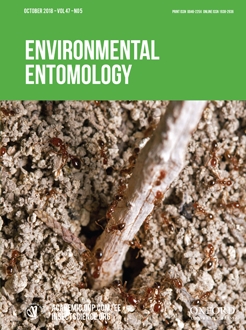Sit-and-wait predators use different strategies to encounter potential prey. Rhinoleucophenga myrmecophaga Vidal et (Vidal et Vilela; Diptera: Drosophilidae) larvae build sticky shelters on top of extrafloral nectaries (EFNs) of Qualea grandiflora Mart (Vochysiaceae), a common plant in the Brazilian cerrado savanna. Although larval shelters block the EFNs, nectar production is not obstructed and is used by the larvae to attract and trap nectar-gathering ants that are eventually eaten by the dipteran. Here we describe the natural history of R. myrmecophaga, its infestation pattern in Q. grandiflora, the ant assemblage at EFNs, and the insects used as prey. We use stable isotope composition (δ13C and δ15N) of R. myrmecophaga and potential food sources to infer its diet, and perform chemical analyses of the droplets found at shelter openings to determine whether nectar is used as a prey attractant. We found that Rhinoleucophenga larvae occur on the majority of Qualea plants and occupy active EFNs mainly in the rainy season. The two most frequent visiting species were also the most common insects found trapped at larval shelters. The stable isotope analyses confirmed that ants are the main food sources of R. myrmecophaga. Chemical analyses and field observations revealed that Rhinoleucophenga larvae use extrafloral nectar to attract prey to their shelters by pushing this liquid to the shelter opening where it forms a droplet. This is a rare case of sit-and-wait predator exploiting an ant-plant mutualism through the use of the very food reward produced by the plant to attract and capture potential ant mutualists.
How to translate text using browser tools
11 July 2018
Natural History of a Sit-and-Wait Dipteran Predator That Uses Extrafloral Nectar as Prey Attractant
Mayra C. Vidal,
Sebastián F. Sendoya,
Lydia F. Yamaguchi,
Massuo J. Kato,
Rafael S. Oliveira,
Paulo S. Oliveira
ACCESS THE FULL ARTICLE
It is not available for individual sale.
This article is only available to subscribers.
It is not available for individual sale.
It is not available for individual sale.

Environmental Entomology
Vol. 47 • No. 5
October 2018
Vol. 47 • No. 5
October 2018
Cerrado
Drosophilidae
insect behavior
sit-and-wait predator
trophic interaction




